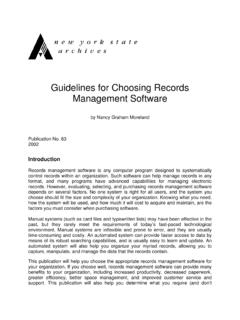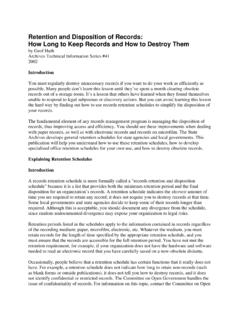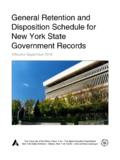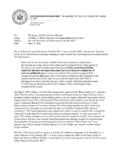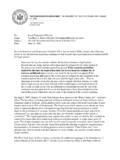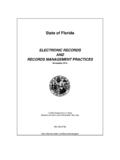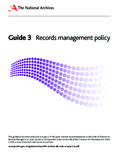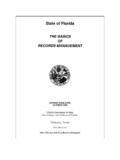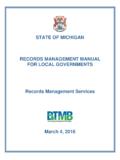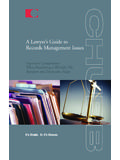Transcription of The First Steps in Records Management
1 NN UU MM BB EE RRNN UU MM BB EE RRN U M B E RIInnvveennttoorry y aannd d PPllaannnniinngg: :The First Steps in Records Management By Suzanne Etherington and Ann Marie Przybyla 2003 This booklet replaces the following State Archives publications: Publication # 24, Guidelines for Planning and Conducting a Records Inventory Publication # 43, Guidelines for Planning Local Government Records Programs N U M B E R 76 The University of the State of New York The State Education Department New York State Archives Government Records Services Albany, New York 12230 President of The University and Commissioner of EducationChief Operating OfficerDeputy Commissioner for Cultural EducationActing Assistant Commissioner and Director of OperationsChief.
2 Government Records ServicesRequestsfor additional copies of this publication may be made by contacting the State Archives, Grants Administration andProgram Support Unit, Room 9A68, Cultural Education Center, Albany, NY UNIVERSITY OF THE STATE OF NEW YORK Regents of The University ROBERT M. BENNETT, CHANCELLOR, , .. Tonawanda ADELAIDE L. SANFORD, VICE CHANCELLOR, , , .. Hollis DIANE O NEILL MCGIVERN, , , .. Staten Island SAUL B. COHEN, , , New Rochelle JAMES C. DAWSON, , , , .. Peru ROBERT M. JOHNSON, , .. Huntington ANTHONY S. BOTTAR, , .. North Syracuse MERRYL H.
3 TISCH, , .. New York GERALDINE D. CHAPEY, , , .. Belle Harbor ARNOLD B. GARDNER, , .. Buffalo HARRY PHILLIPS, 3RD, , .. Hartsdale JOSEPH E. BOWMAN, JR., , , , , .. Albany LORRAINE A. CORT S-V ZQUEZ, , .. Bronx JUDITH O. RUBIN, .. New York JAMES R. TALLON, JR., , .. Binghamton MILTON L. COFIELD, , , .. Rochester President of The University and Commissioner of Education RICHARD P. MILLS Chief Operating Officer RICHARD H. CATE Deputy Commissioner for Cultural Education CAROLE F. HUXLEY Acting Assistant Commissioner and Director of Operations CHRISTINE WARD Chief, Government Records Services ROBERT W.
4 ARNOLD The State Education Department does not discriminate on the basis of age, color, religion, creed, disability, marital status, veteran status, national origin, race, gender, genetic predisposition or carrier status, or sexual orientation in its educational programs, services and activities. Portions of this publication can be made available in a variety of formats, including braille, large print or audio tape, upon request. Inquiries concerning this policy of nondiscrimination should be directed to the Department s Office for Diversity, Ethics, and Access, Room 530, Education Building, Albany, NY 12234.
5 Requests for additional copies of this publication may be made by contacting the State Archives, Grants Administration and Program Support Unit, Room 9A68, Cultural Education Center, Albany, NY 12230. Inventory and Planning: The First Steps in Records Management TTaabblle e oof f CCoonntteenntts sIntroduction .. 1 Planning the Inventory .. 2 Conducting the Inventory .. 3 Using the Inventory Data .. 5 Preparing a Records Management Plan .. 6 For More Information and Assistance .. 8 Appendix A: Records Inventory Data Worksheet .. 9 Appendix B: Instructions for Completing the Records Inventory Data Worksheet.
6 11 Appendix C: Sample Completed Records Inventory Data Worksheet .. 19 Appendix D: Sample Inventory Database Output .. 21 Appendix E: Sample Office Map .. 22 Appendix F: Table of Cubic-Foot Equivalents .. 23 Appendix G: Sample Records Management Plans .. 24 Long-Range Records Management Plan for Capital City, 2003 2006 .. 24 Annual Records Management Plan for Capital City (2003) .. 27 Records Management Plan for North Haverbrook Central School District .. 30 Appendix H: Glossary of Records Inventory and Planning Terms .. 32 Inventory and Planning: The First Steps in Records Management iii iv Inventory and Planning: The First Steps in Records Management IInnttrroodduuccttiioon nA Records inventory is the foundation of sound Records Management , and is often the First step in establishing a Records Management program.
7 No matter how you organize your Records , an inventory can provide an overview that will help you manage these Records in the future. During an inventory you will locate, identify, and describe all Records series held by your local government or state agency, whether the Records are in electronic, paper, micrographic, or any other format. At the end of an inventory, you will have a good idea of the type and quantity of Records created and maintained by your local government or agency, and probably some understanding of how to manage them more efficiently. After completing the inventory, you should conduct both an appraisal and a needs assessment to help you assemble short- and long-term plans for managing your Records .
8 These four components inventory, Records appraisal, needs assessment, and Management plan are essential Steps in developing a strong Records Management program. This booklet provides local governments and state agencies with advice on how and when to conduct an inventory and how to plan for the development or improvement of a Records Management program. Although the process of conducting an inventory may be time-consuming, in the end you should see many advantages. An inventory can help you manage your Records more efficiently help local governments and state agencies meet the Freedom of Information Law requirement to maintain a subject matter list of Records help you clean house by forcing staff to identify and discard unnecessary Records teach you about the Records your organization maintains, so you can formulate sound plans to guide and develop your Records Management program.
9 Inventory and Planning: The First Steps in Records Management 1 PPllaannnniinng g tthhe e IInnvveennttoorry yGet support Support from everyone who creates or uses Records is critical for a successful inventory, since inventory workers will be in and out of storage and office areas and will probably ask the rest of the staff questions about specific Records . If upper Management supports an inventory, then securing cooperation from everyone else will be easier. Let staff know the purpose and timetable of the inventory and reassure them that an inventory is not an audit. The Records Management officer (RMO) should actively oversee the inventory, whether it is carried out by workers hired for the project or by current staff.
10 An organizational chart will help inventory workers determine who to contact across the government or agency, and how departments and their Records relate to one another. Set a schedule Develop a timetable that clearly assigns responsibility for all activities, estimates the inventory schedule for each area, and allows time to both evaluate the inventory and develop a program plan. The timetable should include clear deadlines, although you may have to adjust the schedule as work progresses. The plan should lay out the schedule of department and unit inventories, with estimates of staff hours necessary to complete each task.
